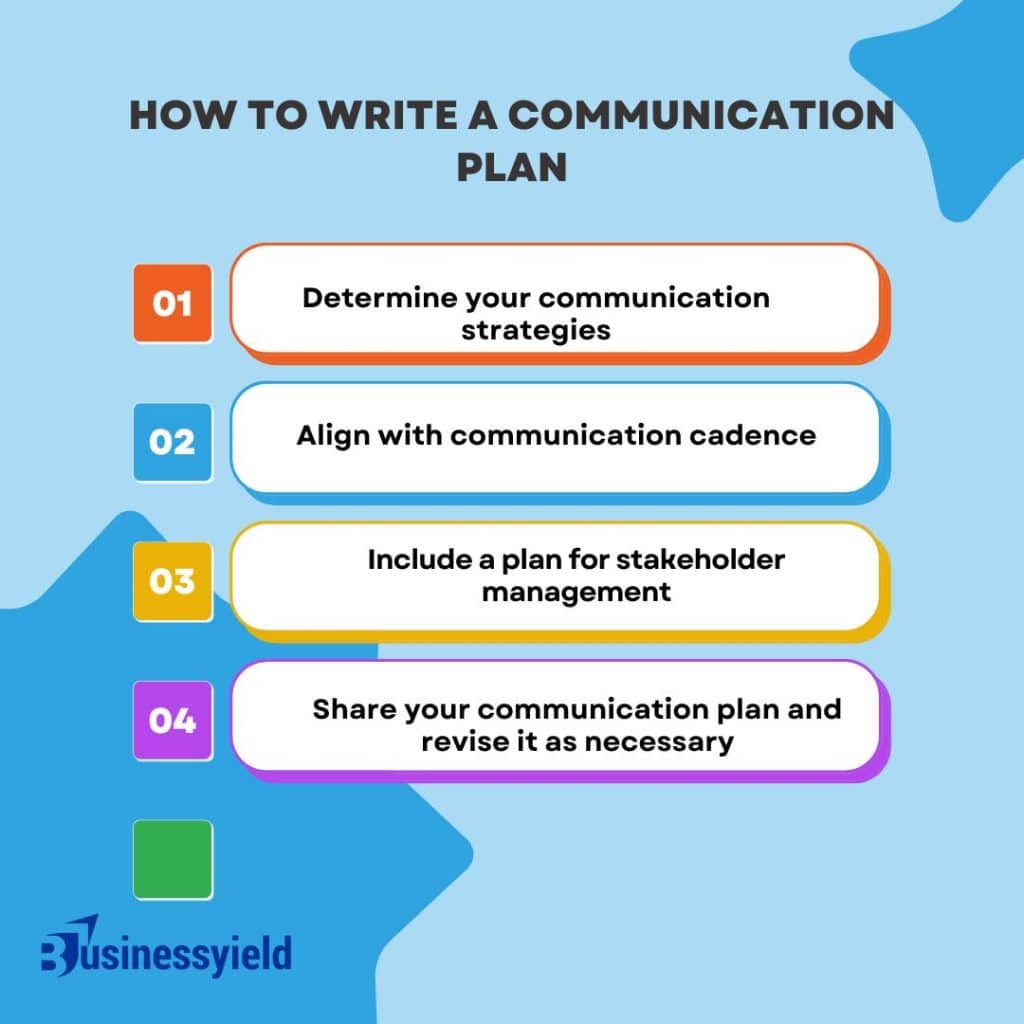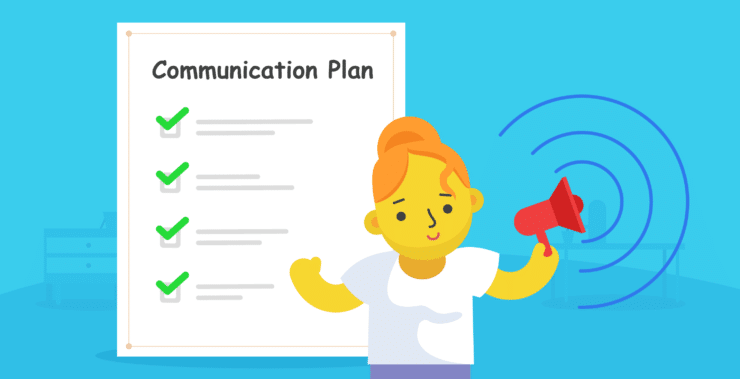I once collaborated extensively with senior leadership to develop an email that addressed late delivery. When we originally started, we had a lot of ideas about how to approach the project and what tone of voice would work best for our organization. I began reading and researching to find what I thought would be an effective strategy for communicating with our target audience. I reached out to communication experts and we were able to construct a communications strategy plan that we used again for all of our marketing and communication initiatives. So in this article, I’ve put together the pointers that will help you create a perfect communication plan for the success of your business.
What is a Communication Plan?
A communication plan, often known as a communication strategy, is a tool that helps marketing or public relations teams synchronize their communications and create consistent messaging. The strategy often specifies the plan for delivering a message to a target audience, as well as identifying the message’s goal, tasks, and expected commercial outcomes.
Communication plans might cover internal or external communications, as well as the communication strategy for a specific project. Frequently, they serve as the core of an organization’s overall marketing strategy. Implementing a communication plan can have several advantages, including:
- Clarity: Having a communication plan can assist an organization gain clarity on how to interact with one another or with clients. Increased clarity may allow staff to communicate with clients and consumers more effectively because they have a better comprehension of essential messaging and communication objectives.
- Guided communications: You can use this strategy to guide marketing communications, such as when introducing a new product. The strategy can define the target audience, key themes, and other factors that are critical to a successful marketing campaign.
- Consistency: Communication techniques can assist an organization in maintaining consistency in internal and external communications. It guarantees that both modes of communication convey consistent and unified themes.
Key Takeaways
- A communication plan helps an organization clarify how to interact effectively with both internal and external stakeholders, ensuring that all staff have a comprehensive understanding of key messages and communication objectives.
- The plan serves as a strategic guide, particularly useful during initiatives like product launches or marketing campaigns, specifying target audiences, key messages, and other critical elements for success.
- By providing a structured approach to disseminating information, a communication plan ensures consistency across all forms of communication, aligning messages with the organization’s goals and brand identity.
- Organizations with a structured communication strategy experience significantly fewer misunderstandings, with reports indicating a 70% decrease in miscommunication, which is particularly beneficial during complex marketing campaigns.
- Effective communication plans should include details on the types of communication to be used, the identification of the target audience, the frequency of communication, the channels for dissemination, and procedures for documentation and archiving.
The Importance of Communication Plan
According to Business News Daily, organizations with defined communication strategies report a 70% decrease in miscommunication. This is a big gain, particularly when working with sophisticated marketing campaigns with numerous moving pieces.
Businesses require communication strategy for a variety of reasons:
- They help keep everyone on the same page.
- They can avert or lessen the effects of potential catastrophes.
- They can help to increase productivity and enhance workflows.
- Communication plans are important because they help firms operate more easily and successfully.
- A crisis communication plan can help to prevent or lessen its impact.
Components of a Communication Plan
- A communication plan specifies who should receive specific information when it should be provided, and the channels utilized to convey it.
- A good communication plan anticipates what information should be conveyed to certain audience segments.
- The plan should also specify who has the authorization to convey confidential or sensitive information, as well as how information should be disseminated—via email, websites, printed reports, and/or presentations at virtual or in-person meetings.
- The plan should also specify which communication methods stakeholders will use to solicit feedback, as well as how communications will be documented and archived.
- A communication plan typically includes the following elements: types of communication (e.g., paging system announcements, automated text messages, email alerts, prerecorded phone calls, meetings, social media), who communicates what information to whom, frequency of communication, and documentation/archiving procedures.
- Finally, a communication plan should be adapted to the specific needs of the business and the people involved, as well as reviewed and updated regularly to ensure its relevance and effectiveness.
Examples of Communication Strategy
Review this example of a communication plan to assist you in developing and implementing your strategy.
Lifetime Audio Systems
Oct. 1, 2023
Communication Strategy for InternalCommunication
- Objectives:
- Share brand messaging among the organization’s 125 employees. Provide an internal document that workers may use to govern their discussions with consumers.
- Encourage staff to speak boldly about brand messaging to boost the company’s reputation.
- Target audience:
- The target audience consists of all 125 Lifetime Audio Systems personnel, with a focus on the sales and customer service areas. These individuals possess a thorough awareness of the company’s products and clients.
- Key messages:
- Lifetime Audio Systems strives for 100% client satisfaction by offering high-quality goods.
- The organization pledges to reply to customer queries, requests, and issues within 24 hours.
- The organization provides a variety of payment plan choices to help clients find inexpensive ways to make purchases.
- Tactics:
- The marketing department wants to publish an internal newsletter for staff each month. The email may contain information about impending sales or new products that employees can share with customers.
- Communication channels:
- On the first day of each month, the marketing department aims to deliver the newsletter via email.
- The team also plans to produce a one-page leaflet emphasizing essential information from the newsletter for the workplace break area.
How To Write a Communication Plan

A communication plan is a valuable tool, but it is also rather simple to construct. You may make a communication plan in four steps.
#1. Determine your communication strategies
The first step in developing a communication plan is deciding where your team will communicate—and what. This includes when to utilize which tools and when to communicate synchronously versus asynchronously. Live, synchronous communication refers to communication that occurs in real time. Asynchronous communication is when you transmit a message without expecting a response right away. We all utilize asynchronous communication daily without recognizing it, most notably when we send emails.
Determine what each instrument will be used for as you design your communication plan. For example,
- You may utilize email to communicate with external stakeholders.
- Slack allows for simultaneous communication concerning daily updates and fast questions.
- Asana allows you to communicate asynchronously about work, such as task details, project status updates, and essential project documents.
- Use Zoom or Google Meet for any team meetings, such as project brainstorming or post-mortems.
#2. Align with communication cadence
Now that you know where you’ll be communicating, you must also determine how frequently you’ll be communicating. Your communication cadence is your action plan for keeping different stakeholders informed about project details.
For instance, you may choose to schedule:
- Weekly project progress updates are distributed via Asana to all project stakeholders and sponsors.
- Monthly project team meetings to unblock work and plan future steps.
#3. Include a plan for stakeholder management
Obtaining stakeholder support and buy-in is often critical to the success of a project. You will accomplish this at the project start meeting, but it is also vital to maintain stakeholder support throughout the project.
As you develop your communication plan, take the time to describe when and what you will communicate with each project stakeholder about. Some people, such as your essential project team members, will communicate about the project frequently—perhaps even daily. Other project stakeholders may only need to be notified during project progress updates, or at the final readout.
By outlining how you plan to manage communication with stakeholders, you can guarantee that they are contacted at the appropriate time and about the appropriate topics. The communication customers get should address their specific questions while also focusing on business results and broader, high-level effects.
After you’ve developed your communication plan, it’s time to discuss it with your project team. Make sure your communication plan is easily accessible in your project’s central repository of information. We recommend utilizing Asana to monitor all project communication and activity, allowing you to discuss work while you’re working.
If anything changes in your project communication plan, make sure to update it and communicate the changes. This ensures that team members always have the most up-to-date information.
Crafting Your Communication Plan Template: Basic Components
There are many communication plan templates available online, but a good one should include the following critical elements:
- Campaign Goals and Objectives: Clearly establish your marketing goals. Is it about raising brand awareness, driving more website visitors, or generating leads?
- Target Audience: Determine your ideal consumer personas, including demographics, needs, and communication styles.
- Messaging and Key Talking Points: Create consistent messaging that resonates with your target audience.
- Communication channel: Outline the communication channels you’ll employ to reach your target audience (e.g., social media, email marketing, influencer collaborations).
- Content Calendar: Make a schedule for creating and distributing content across several media.
- Team Roles and Responsibilities: Assign clear roles and duties so that everyone is on the same page.
- Budget and Resources: Use resources wisely to support your communication strategy.
- Establish Key Performance Indicators (KPIs) to track the success of your communication plan and identify areas for improvement.
Remember that a communication plan is a living document. As your marketing campaign proceeds, examine and tweak it to reflect new data and performance metrics. You can check out our free communication plan template below.
This template provides a structured approach to planning and executing effective communication strategies, ensuring that all relevant parties are informed, engaged, and aligned with the project goals.
Communication Plan Examples
- Strategic Communication Plan.
- Project Communication Plan
- Marketing Communication Plan
- Corporate Communication Plan
- Crisis Communication Plan
Communication plans might be difficult to write, but an effective one will stand the test of time. The communication plans below include an analysis of the stakeholders to whom you would reply, as well as protocols for what should be included in those communications.
#1. Strategic Communication Plan
Bright Hub Project Management’s communication plan defines how, when, and why communication takes place inside the business.
This example is excellent since it describes how communication managers write crisis plans while also acknowledging that the busy marketer or project manager may occasionally take on this role.
#2. Project Communication Plan
Here’s an example of Simplicable’s billing upgrade project. This communication plan outlines all of the crucial meetings and documents required for the project. As you can see, it comprises the necessary parts such as audience, goals, format, and DRI.
#3. Marketing Communication Plan
A marketing communication plan is vital for interacting with your target market, especially when introducing new products or projects. This Smartsheet example demonstrates how to plan marketing communications plans for customers, sales prospects, media partners, internal stakeholders, and events.
#4. Corporate Communication Plan
Corporate communication plans describe how firms communicate both internally and externally. This Smartsheet example shows a nine-step roadmap with sections for a mission statement, executive summary, situation analysis, key messaging, and more.
Conclusion
Implementing a well-defined communication plan can guarantee that your marketing activities are consistent, focused, and measurable. It encourages team collaboration while also communicating a clear, consistent message to your audience.
So, the next time you plan a marketing effort, don’t ignore the importance of communication. A well-crafted communication plan can be the hidden element that lifts your marketing efforts from mediocrity to success! Have you ever had firsthand experience with the benefits of a communication plan? Share your stories in the comments section below!
- Stakeholder Engagement: How to Plan an Effective Engagement Strategy
- Stakeholder Management: Planning And Strategies
- WHO IS A STAKEHOLDER? Meaning, Types & Importance
- Stakeholder Mapping: Guide to the Mapping Tool for Effective Stakeholder Management
- STAKEHOLDER THEORY: Definition, Benefits, and Challenges





